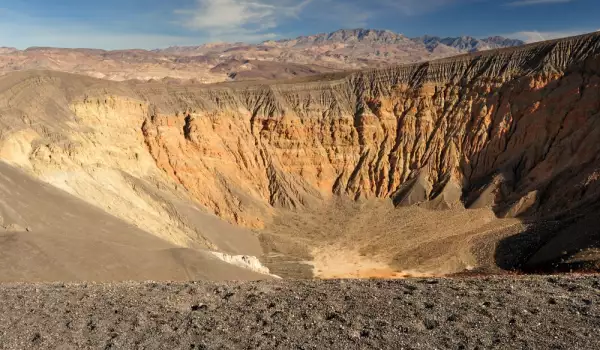Ubehebe Crater

Ubehebe Crater is a volcanic crater that is located in the volcanic field of Ubehebe craters in the northern part of Death Valley National Park, in Death Valley in California.
Ubehebe Crater is located in the mountain Cottonwood. The crater size is impressive - it is one kilometer wide and 237 m deep. The crater was created seven thousand years ago. The crater was formed at Ubehebe when magma has approached the hot surface and the flow of magma was erupted, it ejects huge amounts of magma and rock fragments. This magma erupted through a hole in the mountain Tin. This lava flow has totally changed Cottonwood mountain.
Ubehebe name means "large basket on the rocks" in the ancient language of the Indians Timbisha. Originally, the crater was known as Tem-pin-tta-Wo'sah, which means "basket of coyotes."
As a result of large explosions of steam, large volcanic craters were formed. Ubehebe is the last and largest such crater that was formed in these eruptions. Near it is Little Hebe. In one of the Ubehebe explosions pyroclastic flow was thrown out. This happened after a big pillar of steam was thrown into the sky and a donut-shaped cloud appeared, which consisted of gas and volcanic ash. Once the magma erupted, it met with surface water and thus formed the volcano type Maar. The western part of Maar volcanoes in Death Valley was formed first, then followed the south.
A sturdy base and walls of the crater are formed in Ubehebe Miocene and are red-orange in color. These sediments contain limestone, quartzite and volcanic cobbles, which are twenty centimeters in diameter. Part of the sediments are yellow, others bright orange. The difference in color is due to the difference in age, in which various sediments were deposited. Ubehebe’s crater bottom is completely covered with special white silt, as is the roof and the bottoms of some craters in nearby Death Valley.

Tourists can go on special paths, which are three in number. One of them leads to the bottom of the crater, the other passes along its edge, and the third leads to Little Hebe. But you have to provide special equipment, as the winds along the edge of the crater Ubehebe reach eighty km/h.
The road to the bottom of the crater is easy, but climbing up can be exhausting. A walk around the edge is moderately difficult, but requires concentration and experience in similar walks. It is a mile and a half long - this is the distance of the round trip. This route can take you to some small craters.
When you go this route, stay on the trail since the very edge of the crater is very loose, making it extremely unstable.
Ash explosions from the volcano covered much of the area around the crater Ubehebe. Ash is visible from afar, it appears when you drive up the hill to the parking area. Ash is seen in the dry bed of the ancient Lake Rogers, which is in the northern part of Death Valley. At the edge of the crater Ubehebe ash is higher that one hundred and fifty feet.
Water erosion has created deep gorges that are visible on the east side of the crater. At the bottom of the crater are the Ubehebe lakes, which had a very short lifetime. Of them remained different shades of pink and brown sediment. There are many clusters of craters on the west and south of Ubehebe, towards Little Hebe.














